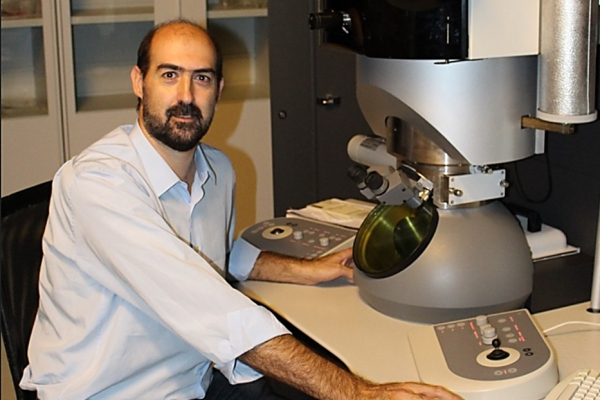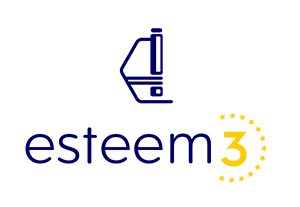ESTEEM3 interviews : Raul Arenal from LMA-Universidad de Zaragoza

Raul Arenal is the group leader of the Nanoscopy on Low Dimensional Materials (NLDM, at the INMA, CSIC-U. Zaragoza) and the coordinator of the TEM area at the LMA-U Zaragoza.
In this interview, Raul Arenal will explain his background, his role, and his views about ESTEEM3.
Question 1 : Tell us something about yourself, your background, and your team.
After a MSc in Grenoble (France) where I developed in situ XRD investigations on magnetic thin films at the CEA-Grenoble, I moved to Paris (Châtillon) to do my PhD thesis (MSCA student) at the ONERA-CNRS under the supervision of Dr. Annick Loiseau and co-supervision of Prof. Angel Rubio (U. Pais Vasco, Spain). The thesis was focused on the synthesis and studies of single-walled boron nitride nanotubes. These studies required detailed electron microscopy investigations for knowing the structure and the chemical composition of these nanostructures. Thus, from the very beginning of these works in 2001, I started working at the LPS-Orsay in the group of Prof. Christian Colliex and under the supervision of Prof. Odile Stephan. This was a great experience and a very exciting period. We got very interesting results in EELS (chemical analyses, optoelectronic properties investigations of these nanomaterials). After the PhD, I got a postdoctoral position at the Electron Microscopy Center of Argonne National Laboratory (USA, 2005-2007), under the supervision of Dr. Dean Miller and Dr. Nestor Zaluzec. This was also a very productive stay, working on EELS and nanobeam electron diffraction in new materials and following the developments and achievements of the TEAM project (DOE, USA). In 2007, I got a CNRS position at the ONERA-CNRS. Late in 2010, I moved to Spain for a stay (visiting researcher) of 16 months at the Laboratorio de Microscopias Avanzadas (LMA), at the Instituto de Nanociencia de Aragon (INA), Universidad de Zaragoza, and at the end of 2011, I got an ARAID position in this Institute. Now, I am the group leader of the Nanoscopy on Low Dimensional Materials (NLDM, at the INMA, CSIC-U. Zaragoza) and the coordinator of the TEM area at the LMA-U. Zaragoza.
The research that we are developing in the NLDM group is focused onthe atomic structure and configuration studies, as well as physical (electronic, optical, vibrational) properties investigation of low-dimensional nanomaterials based on carbon, transition metal dichalcogenides and related materials as well as other nanostructures (in particular, metallic nano-objects for plasmonic/photonic interest).
Question 2 : Tell us briefly about the last original research you have conducted.
We are working on different interesting 1D, 2D materials as well as on other nanostructures for photonics, catalysis applications… Thus, among them, I would like to highlight our works on in situ thermal reduction of graphene oxide (GO), as I consider that they are interesting for both graphene community and TEM community. They have been recently published (Carbon 178, 477-487 (2021) and 2D Materials 8, 031001 (2021)). In collaboration with Prof. Wolfgang Maser and Dr. Ana Benito (ICB-CSIC, Spain), we have studied, coupling different TEM techniques (mainly EELS, but also HRTEM and electron diffraction), the different steps/processes during the thermal reduction and graphitization of GO. We have also measured how this reduction affects the electrical conductivity of this material.
In addition, in the framework of my long-term collaboration with the team of Prof. Reshef Tenne (Weizmann Institute, Israel) and this one of late Prof. Leela Panchakarla (IIT-Bombay, India), we have investigated several 1D systems based on misfit layered compounds (Materials Horizons 9, 2115 (2022); J. Amer. Chem. Soc. 144, 10530 (2022); Proc. Nat. Acad. Sciences 118, e2109945118 (2021); ACS Nano 14, 5445 (2020)). The TEM studies have provided significant information about the structure of these materials, their stability, their growth mechanism and even their optoelectronic properties. Some of this research has been carried out as transnational access (TA) requests.
I would also like to highlight the developments that, with Dr. Simon Hettler (postdoc in my group), we have been carried out to show the advantages of combining aberration correction TEM and phase plates (Ultramicroscopy 239, 113564 (2022) and Ultramicroscopy 227, 113319 (2021)). These works have been also supported by a DFG project.
Question 3 : Present your institute and its tasks within ESTEEM3 ?
The LMA-Universidad de Zaragoza is an initiative aimed at providing the industrial and scientific communities with advanced infrastructures in electron microscopy, nanofabrication, and scanning probe microscopy for the observation, characterization, nanopatterning and handling of materials at atomic and molecular scale. In 2014 the LMA was awarded as Unique Scientific Technical Infrastructure (ICTS) by the Spanish Ministry of Science and Innovation.
Our activities within the ESTEEM3, apart the TA works, mainly concern WP6 (in situ TEM) and WP7 (Materials for ICT), where we are WP-coleaders. We focus on different aspects regarding the activities of these work packages as the development of in situ measurements on several nanostructures (2D, magnetic…), the study of different materials for ITC (functional complex oxides, carbon and related nanomaterials…) using different TEM techniques (EELS, EDS, diffraction, HR(S)TEM, tomography, Lorentz and holography).
Question 4 : Why did you decide to be a part of the ESTEEM3 project ?
We (the UNIZAR’s team, Prof. Ricardo Ibarra (PI), Dr. Cesar Magen and I) were already members of the ESTEEM2. It was a great experience. Thus, the decision to continue in the ESTEEM3 was very easy to take. Now, that the project is almost finished, we can confirm that it was the right decision. The project has been a success and it has been very positive.
Question 5 : What are the most challenging aspects of your role and how do you overcome them ?
Within the ESTEEM3 project, I think that the most challenging aspect that we have handled has been the health emergency (COVID-19 pandemic). This has been a very complicated and exceptional situation for everyone. We have faced very difficult problems at the personal, social, and at the professional/work level. These effects also had an impact in the project (laboratory lockdown, extra delays, slowdown activities…). However, I think that we had adapted accordingly, and we could overcome all these issues.
In a more personal way, one of the main challenging aspects of my role as group leader (or even as a researcher in general in the current times) is to get the funding for supporting our activities. Of course, we can also consider the scientific challenges that we have, but for facing them, we should have some funding. So, there is not a magic recipe, you try to do your best, getting the best environment for proposing and developing breakthrough research.
Question 6 : What is the added value of ESTEEM3 for the European research ?
The activities carried out under the framework of the ESTEEM3 have been very positive for the TA users (e.g., the quality and the amount of the publications produced is a clear proof of the high impact of the project) and for the EM community in general due to the developments obtained within the project. Thus, different scientific communities as well as the industry have benefited of these works. This has a clear impact in the quality of the European research and that is why I consider that we can conclude that ESTEEM3 has played an important role in this sense.
Question 7 : What do you expect for the future of the project ?
I hope that the works being developed under ESTEEM3, both in terms of TA and joint research activities (JRA) carried out via collaborations between partners and technical developments can continue to be done via other European projects. These works supported by this kind of infrastructures’ projects are needed for overcome the very important challenges (energetical, ecological...) that our society must face. Therefore, I hope that European, national, and local/regional administrations will support initiatives/projects along the lines of ESTEEM3 or even more ambitious ones.
